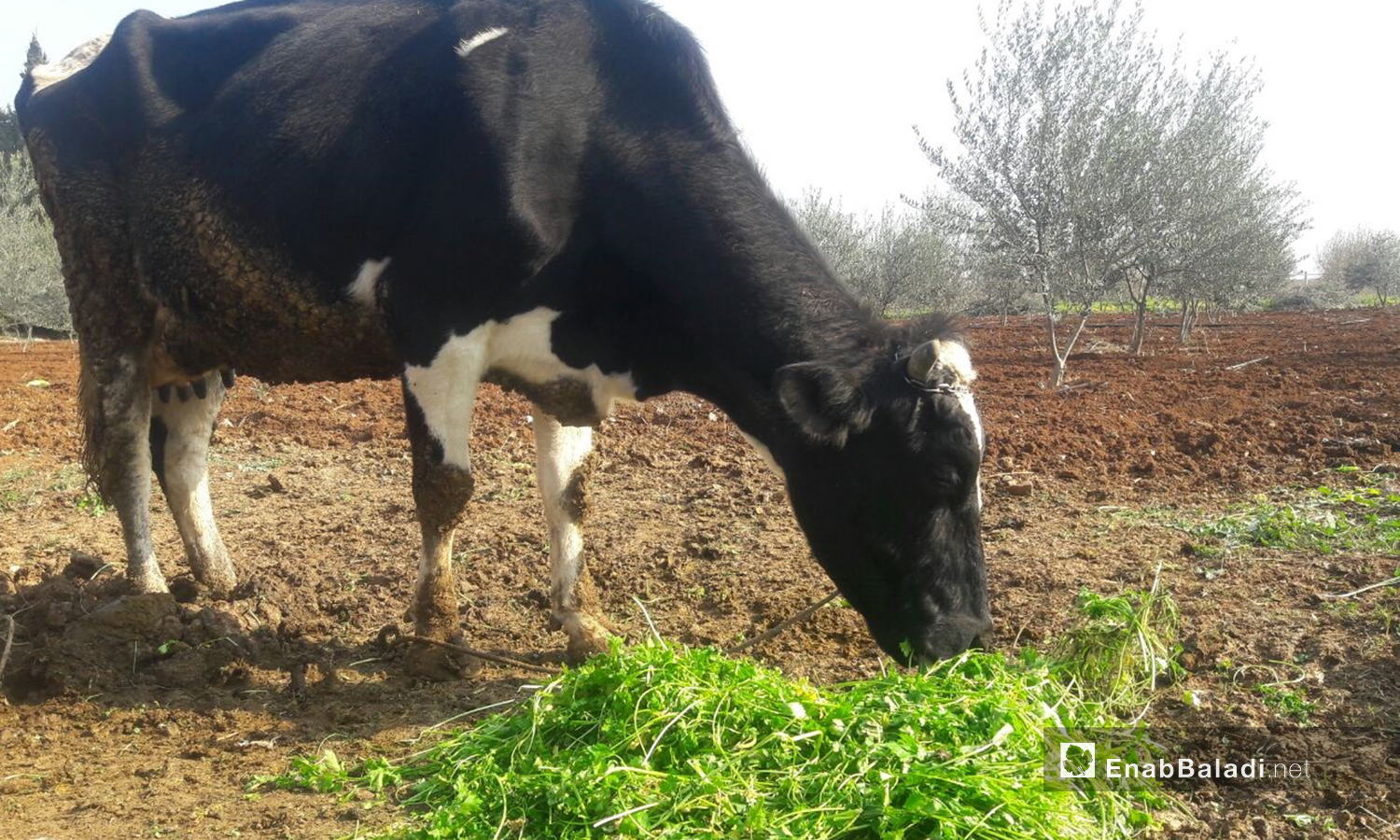



Daraa – Halim Muhammad
The cattle breeder, Ibrahim, 33, can no longer endure his frequent losses due to the disparity between the selling price of milk and production costs in the southern governorate of Daraa, especially following the hike in fodder and hay prices, as well as in treatment costs.
This has not only had an impact on cattle breeders in the southern region, rather, the high prices of diesel hampered the movement of itinerant traders who buy milk from the breeders. The security situation also contributed to the stagnation of milk sales following the closure of a number of factories in the Daraa countryside.
With the beginning of the Russian invasion of Ukraine last February, the fodder market in Daraa saw a marked rise in prices, with the price of a kilogram of fodder for dairy cattle rising from 1500 Syrian pounds (1 US dollar equals about 4000 Syrian pounds) to 2300 pounds and the price of one kilogram of hay (mashed wheat straw residue) going from 600 pounds to 1000 pounds, as did the price of veterinary medicines.
This price rise was not offset by a parallel increase in milk prices. Cattle breeder Ibrahim, who preferred not to reveal his full name for security reasons, told Enab Baladi that “the milk bill (weekly balance sheet) does not cover the price of one bag of fodder per cow. I have incurred debts to grain merchants, and I may have to sell one of the livestock to pay off these financial liabilities”.
The price of milk is not in line with the price of fodder within the city, as the difference has become so large that cow breeders cannot afford the financial losses they suffer. As of the beginning of the current year, the price of milk has only covered the price of fodder without profit or loss. Today, the loss has become inevitable.
In mid-March, cattle breeders in the majority of areas in the western countryside of Daraa refrained from supplying milk, demanding, through this abstention, which took the form of a general strike, to raise the price of what their cows produce. The strike lasted for nearly a week.
The strike prompted traders to raise the price of milk from 1200 to 1500 Syrian pounds. According to cattle breeder Ibrahim, this slight difference may compensate for some of the loss.
The collective refusal of cow breeders to supply milk “was our only option,” said Ibrahim. “We pressured merchants into raising the price of milk. The breeders were cooperative, so we were able to raise an additional 300 pounds, and this is good to mitigate our losses.”
Prior to 2011, Syria’s livestock accounted for about 40 percent of total agricultural production and secured employment for about 20 percent of the rural workforce.
On average, about 35 percent of rural households considered livestock farming the main source of food and income.
Every morning, merchants would roam the neighborhoods in the villages of Daraa to collect milk from the breeders’ homes in agricultural vehicles designated for this task. Merchants supply milk to dairy and cheese factories, grocery stores, and ice cream factories, which consume significant quantities of milk during the summer season.
The hike in diesel fuel prices reduced Daraa merchants’ profit margin; the price of one liter of diesel fuel went from 2800 Syrian pounds (0.71 US dollars) to 5500 pounds. Enab Baladi polled the views of several itinerant milk traders, who were unanimous on the fact that the price of diesel fuel is causing them a real loss and that some of them are thinking of leaving the milk trade and moving to another field of trade.
Security conditions in Daraa, characterized by the spread of assassinations and kidnappings, prompted some owners of milk factories to close them, while others have relocated to the capital, Damascus.
One of the factory owners in Khirbet Qais village in the western countryside of Daraa was previously subject to two kidnapping attempts. The deteriorating security situation forced him to close his factory, which used to handle nearly five tons of milk per day. Another factory was closed due to similar circumstances.
These factories used to purchase traders’ production and save them the cost of diesel fuel, seeing that the traders would sell their production at once.
The deteriorating economic reality of Daraa residents also played a role in the milk recession, which prompted them to either dispense with milk or reduce its consumption; although it is one of the necessary food items in every house in the city; a consumer buys a kilogram of milk at the price of 2000 Syrian pounds, while a kilogram of yogurt costs 2700 Syrian pounds. One kilo of labneh (strained yogurt) costs 8000 Syrian pounds, and a kilo of homemade cheese costs 11,000 Syrian pounds.
(1 US dollar is traded for about 4000 Syrian Pounds)
if you think the article contain wrong information or you have additional details Send Correction